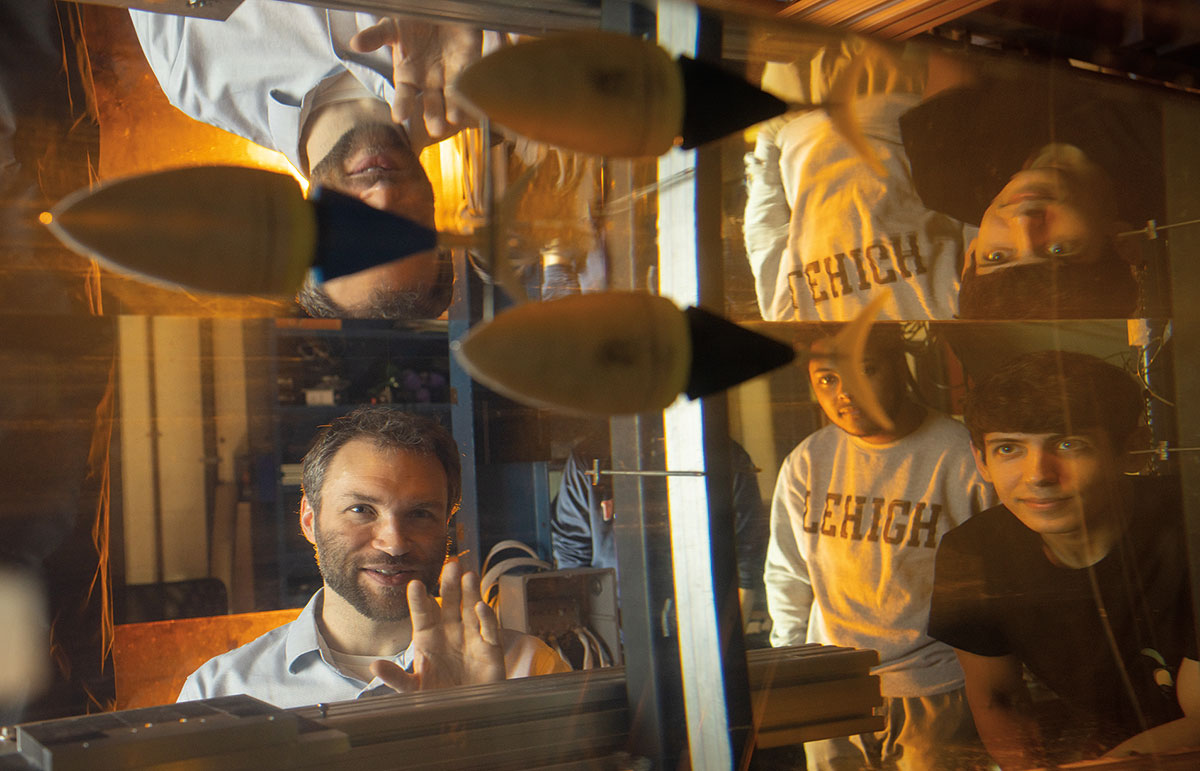
The Lehigh team, led by Lehigh Associate Professor Keith Moored (left), will also conduct fluid dynamics simulations to better understand the fundamental physics behind fish schooling. (Photo by Douglas Benedict/Academic Image)
Keith Moored, an associate professor of mechanical engineering and mechanics, and colleagues from the University of Virginia and Harvard and Princeton universities aim to discover and demonstrate the hydrodynamic principles behind high-speed, high-efficiency fish and bio-robotic schooling.
The interdisciplinary team has been awarded $7.5 million from the U.S. Department of Defense—through a five-year Multidisciplinary University Research Initiatives (MURI) award—to help develop fast and efficient schools of bio-inspired underwater vehicles.
“It’s important, particularly from the Navy’s perspective, in order to build the next generation of underwater vehicles,” Moored says. “If you look at how the military operates in the air, we have drones that can do all sorts of things, but we don’t have that same kind of equivalent underwater. The Navy has been trying to invest in underwater drone technology that can serve a lot of purposes—where you can keep people out of harm’s way and do things like surveillance and reconnaissance, but also underwater mine detection and removal.”
Moored says that a deeper understanding of fluid dynamic interactions will enable bio-inspired robots to perform these tasks more effectively and with less energy as a group, just like fish in a school.
“We know that there are some benefits by having fish swim together, from a performance standpoint,” he says. “They can actually swim faster when they swim together. They can actually swim more efficiently as a group than they can individually. What we’re looking at is, really, understanding this better, so that ultimately, we can design a school of bio-inspired robots to swim together in a beneficial way. And when [the bots] are deployed for a mission, they can go do distributed tasks, so that it’s not just one bot going to do something, but they can spread out and go map an area, do reconnaissance or surveillance on other underwater vehicles, sweep for mines, or other missions.”
The team—which includes Daniel Quinn, Haibo Dong, and Hilary Bart-Smith (UVA); George Lauder (Harvard); and Radhika Nagpal (Princeton)—will address three key, unresolved questions to reveal the hydrodynamic principles behind schooling: What are energy-reducing schooling states? Do the organization and synchronization of fish schools make full use of hydrodynamics? And, how is high-performance schooling achieved through the fusion of hydrodynamic principles and control?
“We’re really trying to understand how we derive hydrodynamic benefits and what is the optimal schooling pattern in order to do that,” Moored says. “The placement of fish within the school changes what kind of benefits are derived, but also the synchronization of their tail motion matters a lot too. We need to understand that kind of space better, of how the synchronization and placement of fish affects the hydrodynamic benefits.”
Additionally, Moored says, “There are also forces that push and pull the fish around in the school that are derived completely from the hydrodynamic interactions between the fish. That may be linked to how the fish school is actually arranged in terms of its formation. We’re trying to understand these pushing and pulling forces and whether they’re sculpting the patterns of formations that we see in real fish schools, and whether that’s something we can take advantage of in a robotic system.”
Ideally, Moored says, researchers might be able to have the robotic devices swim in a specific formation by taking advantage of the right physics, rather than having to build controllers to affect their positions.
The team will build robotic devices as test beds and scientific demonstrators to prove, or disprove, hypotheses. They are currently working with tuna bots developed by Bart-Smith’s team that are about eight to 10 inches in length, and blue bots created by Nagpal that are about five or six inches in length.
At Lehigh, the project will fund one postdoctoral scholar, two graduate students, and several undergraduate researchers each year. All told, some 30 to 40 researchers will be involved in the project.
Lehigh will focus its expertise on the fundamental physics involved.
“We take abstractions of these robots,” Moored says. “For instance, we may look just at a model of the tailfin by itself, which is the main propulsive element of the specialized robots, and we will look at having two or more of these tailfins by themselves interacting. That abstraction is useful because it has all of the salient features of these robots. Some of the details are missing, which makes things simpler for us to analyze it with, but it has enough of the physics there that we can understand these kinds of complex interactions much better. We’re going to do these simpler experiments with what we call hydrofoils interacting with each other.”
The team will push out what it learns about optimal placement and synchronization of the swimming hydrofoils to the other researchers for additional testing, experiments, and demonstrations.
